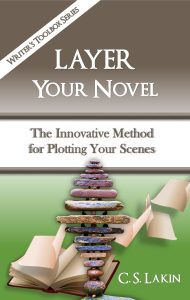The 5 Turning Points in Your Novel
Almost every great story has five turning points. Movie, play, novel—regardless of genre. Traditional story structure goes way back to ancient storytellers sitting by the fire and regaling listeners with their tales. While we didn’t live back then, we can assume their stories had these essential five turning points. They’re the foundation of practically ever story we’ve ever heard.
If you’re writing fiction, you need to know what these turning points are. While short stories don’t often conform to this structure, you will see it sometimes. But if you’re writing a novel, this post’s for you.
Turning Point #1:“Opportunity” Knocks
Turning Point 1: “Opportunity.” Yes, this is the inciting incident. Michael Hauge puts it so nicely: “An event occurs that creates desire in the protagonist. Reader gets a glimpse of their longing or need.”
Ah: core need. How often I harp on this. Protagonists (and all main characters) need motivation. We do things for a reason, and your protagonist needs a strong reason to chase after her goal. We bond with characters whose needs are clear. We see what they care about, what they’re passionate about, what they love to do, what they believe in. But underneath all that is the need. A basic, maybe even primal need.
Every great story has this. Scarlett O’Hara needs love. She sure hasn’t a clue what it is or how to get it. But it’s her core need.
Katniss Everdeen needs to protect and care for her family. Her core need means she has to be courageous and self-sacrificing.
What’s your protagonist’s need? If he doesn’t have one, you’re in trouble. I’ve written dozens of posts and chapters in my writing craft books on the protagonist and his core need. Just type in “core need” in the search bar if your core need is to understand this and why it’s crucial to your story! A protagonist without a core need is like a day without sunshine.
Where Does the First Turning Point Occur?
The other thing so important to understand is this inciting incident or opportunity needs to come at the beginning of your story. By about the ten-percent mark. If you have a four-hundred page novel (well, you may not yet know how many pages your book will end up having, at this point), that incident is going to show up around page forty. Or sooner.
Too many manuscripts I edit and critique are either lacking that important incident or it’s way far into the story. There might be a hundred pages of backstory first, setting up the characters and premise. Or a lot of unimportant scenes that show the protagonist in his ordinary world. Don’t spend forever getting to that first turning point.
Writers often ask me: Where should I start my story? Easy-peasy. Start right before the inciting incident. Next question?
You don’t need to take all that much time for setup, even in a fantasy novel. You just need enough to introduce the protagonist, her core need, the stakes and conflict for the story (personal and public), and the other key players in the story.
The Hunger Games is a great example. We have the opening scenes showing Katniss with her family, showing the world situation, showing her skill at hunting, showing the two key male characters that will be her love interests. And, boom! The reaping takes place, her sister is chosen for the deadly games, and Katniss volunteers as Tribute in Prim’s place.
Turning Point #2: The Goal in Play
This is the point where the protagonist’s goal for the book gets locked in. This involves a visible end point. A finish line. Not something nebulous like “Debby goes after love.” It’s more like “Debby sets out to win John’s love by winning the state chess competition.”
Every story is about someone with some passion going after a specific goal. Why? Because the character has a core need. That core need is the inner motivation that presses Debby to pursuing her goal—to winning that chess match.
Your unique story concept is all about showing how your character goes after her goal amid opposition and high stakes. See, Sally wants to win John’s love too and she’s a better chess player, and the chess competition has a thousand-dollar entry fee, which Debby somehow must raise. So she decides to breed rare hamsters to make bank before time runs out. Or whatever.
So what happens at this turning point? Something has to happen that pushes that new desire created at the inciting incident in the direction of a specific goal. Thelma and Louise, in the inciting incident, feel the need to leave town and go on an adventure, get away from their boring or oppressive life situations. At turning point #2, they leave town.
In this stage of the novel up to the midpoint, the character is off on a course to get her goal. It’s progress and setbacks. It’s discovering opposition (pinch point #1).
Turning Point #3: The Mirror Moment and No Turning Back
Turning Point # 3 takes place at the 50% mark or midpoint. Yes, it’s the midpoint. The midpoint is the full “door of no return.” The character is committed; he’s all-in. He’s gotten a peek of what he’s facing in the way of opposition. It doesn’t mean he won’t slip back, fail, briefly change his mind, have regrets. A good story will have all that.
The midpoint is a crucial part of novel structure. As I’ve explained before, it’s the moment in which something new occurs. Some new major development or complication. Some twist or disruption.
Sometimes it’s the spiritual or emotional place the protagonist comes to, after a series of difficult setbacks or obstacles, where he’s pushed to make a hard decision, go through another “door of no return,” solidify his resolve, and move into further action. It’s a turning point that usually ramps the story up into a higher gear.
Midpoints can also be reversals. Something unexpected happens and changes the worldview of the protagonist. His plan no longer works and things have to change. A good midpoint reversal will also raise the stakes, even if they were already high. It often elevates the personal stakes in a way that wasn’t there before or reveals a secret. Sometimes it requires a sacrifice, be it a personal belief or an ally. It may involve all these things.
The movie Casablanca has a terrific midpoint. Up until that moment, Rick, the bitter, negative, selfish bar owner, has been closed off to everyone and everything else, a bystander watching the war take its toll. At the exact midpoint of the film, Ilsa comes to Rick’s bar after closing. Rick is drunk and treats Ilsa with contempt, reminding her how she’d abandoned him in Paris. Ilsa tries to explain, pleads with him to understand, but Rick will have none of it. She leaves in tears—but not until after she shatters his assumptions. Ilsa had left because she’d learned her husband, Victor, was alive.
Rick, full of self-disgust, puts his head in his hands, finally facing his demons. “What have I become?” This is the moment of decision. Will he stay a selfish drunk or step up and stand up for something more important than his own little problems (which he later calls a hill of beans)? Everything that transpires in the movie is now impacted by his shift in attitude that occurs at the midpoint.
In the midpoint of the lengthy Gone with the Wind, we find Scarlett in that “mirror moment,” reflecting on how the war has destroyed every vestige of her life, her world, and her home, yet, she still has Tara, her family homestead, and in that moment she determines she will do whatever it takes to preserve and rebuild Tara. This midpoint, as are many, reveals an internal, personal shift in attitude.
Turning Point #4: The Dark Night of the Soul
Turning Point #4 comes at the 75% mark. This is the dark moment before the climax. The last push amid the biggest obstacles and challenges. It’s the point when the character wants to quit, feels a failure, loses all support, loses his faith, slides back into whatever previous persona gave him false shelter all these years. In other words, things look hopeless or impossible.
This fourth turning point ushers in the final push for the story in which the character has to buck up, rebound from retreat or setback or loss or failure, and draw on every resource and ounce of determination to stay the course.
Of course, every novel is going to vary in degrees regarding this turning point. But the stronger this “dark night of the soul” moment, the more powerful the story.
In this dark moment, we need to think of all the ways we can make this situation as hopeless as possible. Everything the character has depended on up till now should fail.
Once the character feels all is lost and processes the situation she is in, she essentially looks back on the journey so far—what brought her to this brink of failure—and questions her commitment, beliefs, choices, and actions. If “all is lost” at this crisis point, it only stands to reason she is going to look at how she got here and what possible options there are, if any, for going forward.
Now, at this crucial point in the story, the plan to reach her goal has failed, the obstacles are insurmountable, and the character thinks, “There’s absolutely no way out.” If you’re writing a romance, this is the moment the hero loses all hope of getting the girl. In a mystery, arriving at the truth seems impossible. In a thriller, evil seems to have won.
At this point, too, there’s no retreating or going back. And that means one final hard push toward that goal—often lacking the support of allies the character once had. Often the hero has to go it alone—everyone else is either dead or has abandoned him. It’s this final push that moves the character from the dark night into the big climax.
Turning Point #5: The Climax
Turning Point #5 is another obvious one, but, surprisingly, a whole lot of novels fall way short here. And that’s the big climax. This is the moment when the protagonist either reaches or fails to reach his goal. This is the point in the story when all the internal and external conflict crash head-on.
Everything in your novel has been leading up to this important event in your story. So much rides on the climax. The climax should showcase the ultimate tension and conflict, both inner and outer. It’s the place where the overarching conflict is met, faced, and resolved, and where the protagonist’s goal is reached or lost.
This is where he faces the truth about himself and his world. If your character is victorious at the climax, he will reaffirm his beliefs, embrace his truth, perhaps even defeat his lie about himself and the wound that has hounded him. He may be hurt and in pain, but the valuable lessons learned outweigh the damage. The depths to which your character falls as well as the scope of his transformation is dependent on your genre.
It’s important to keep in mind that the climax may not be just one scene; it could comprise a number of scenes. But when coming up with your ten key scenes, focus on the moment in which the goal is reached.
 These are your important 5 turning points, so be sure to learn all about them.
These are your important 5 turning points, so be sure to learn all about them.
My online course on The 10 Key Scenes That Frame Up Your Novel has dozens of great movie clips, worksheets, and exercises to help you nail your turning points and all your key scenes. Bring your popcorn!
Master novel structure by learning about the Ten Key Scenes. They provide the sturdy framework for a successful story! It’s all in Layer Your Novel, one of the many books in The Writer’s Toolbox Series.
CLICK HERE to get yours today!
Featured Photo by Scott Higdon on Unsplash












Excellent advice!